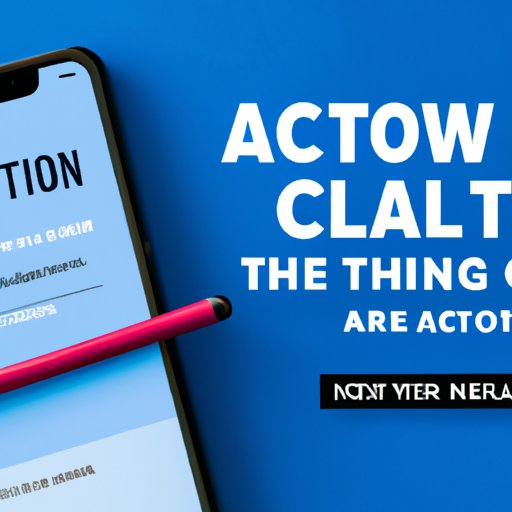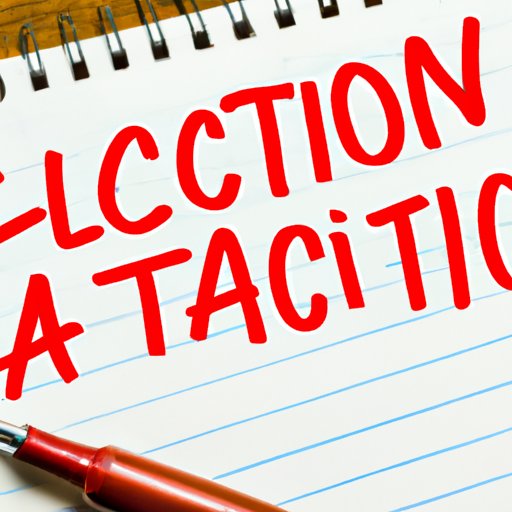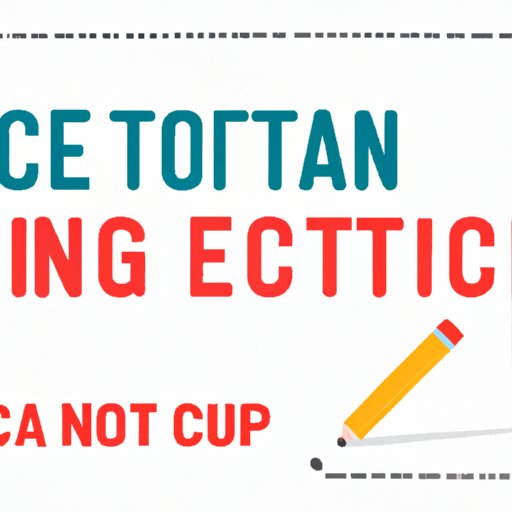Introduction
A call to action (CTA) is a statement or phrase used in marketing and advertising to entice a viewer or reader to take some form of immediate action. It can be used in written content, on websites, in emails, ads, and other forms of communication. It is designed to encourage the audience to do something, such as click a link, sign up for a service, or purchase a product. The purpose of a call to action is to get the reader to take action right away, rather than waiting or considering their options.
The goal of a call to action is to create a sense of urgency and compel the reader to act quickly. By creating a sense of urgency, the reader is more likely to take action immediately. A successful call to action should be clear, concise, and direct. It should provide the reader with enough information to understand what they need to do and why they should do it.
Exploring the Basics of Call to Action Writing: Examples and Tips
Understanding the basics of call to action writing is essential for creating compelling calls to action that get results. Let’s explore the components of a call to action, the benefits of using one, and tips for writing a powerful call to action.
What is a Call to Action?
A call to action is a statement or phrase that encourages the reader to take action. It can be used in a variety of ways, from an email blast to an online ad. It is designed to motivate the reader to take action immediately. A successful call to action should be clear and direct, providing the reader with all the information they need to take action.
Components of a Call to Action
A successful call to action should include the following components:
- A clear and direct message
- An explanation of what the reader needs to do
- A sense of urgency
- A benefit to the reader
- A call to action button or link
Benefits of Using a Call to Action
Using a call to action in your writing can have a number of benefits. It can help you increase conversions, boost engagement, and drive traffic to your website. It can also help you build relationships with your readers, as they are more likely to take action when they feel compelled to do so.

Crafting Compelling Calls to Action in Your Writing
Now that you know the basics of call to action writing, let’s take a look at how to craft compelling calls to action in your writing. Here are some tips for writing a powerful call to action.
Writing an Engaging Call to Action
When writing a call to action, make sure to keep it simple and direct. Avoid using overly long sentences or complicated language. Instead, use simple language that is easy to understand. Make sure to explain exactly what the reader needs to do and why they should do it.
Tips for Writing a Powerful Call to Action
- Make it clear and direct
- Include a sense of urgency
- Provide a benefit to the reader
- Be specific about what you want the reader to do
- Include a call to action button or link

How to Write a Powerful Call to Action That Gets Results
Writing a powerful call to action isn’t easy, but it’s essential if you want to get results. Here are some tips for writing a call to action that gets results.
Defining Your Goals
Before you start writing your call to action, it’s important to define your goals. What do you want the reader to do? Is it to sign up for a newsletter, download a free ebook, or purchase a product? Knowing your goals will help you craft an effective call to action.
Crafting an Effective Call to Action
Once you know your goals, you can start crafting an effective call to action. Make sure to include all the components we discussed earlier, such as a clear and direct message, an explanation of what the reader needs to do, a sense of urgency, a benefit to the reader, and a call to action button or link.
Making It Easy to Take Action
It’s also important to make it easy for the reader to take action. Include a call to action button or link that is clearly visible and easy to click. Make sure the link leads to the correct page or destination. You may also want to consider adding a “call now” button or a “contact us” form to make it even easier for the reader to take action.
5 Examples of Effective Call to Action Writing
Let’s take a look at some examples of effective call to action writing.
Example 1
“Sign up now to get 20% off your first purchase!”
Example 2
“Download our free guide to learn the secrets to success!”
Example 3
“Schedule a free consultation today to get started!”
Example 4
“Subscribe now for exclusive offers and discounts!”
Example 5
“Don’t miss out – reserve your spot today!”

The Art of Writing an Engaging Call to Action
Writing an engaging call to action takes practice and experience. Here are some tips for creating a compelling call to action that resonates with your audience.
Creating Urgency
Creating a sense of urgency is key to getting the reader to take action. Use words like “now” and “today” to encourage the reader to take action right away. You can also use words like “limited time offer” or “last chance” to create a sense of urgency.
Writing to the Audience
It’s also important to write to the audience. Speak directly to them and use language that resonates with them. Use language that speaks to their needs and desires. This will help you create a connection with the reader and get them to take action.
Using the Right Language
Finally, make sure to use the right language. Use language that is positive and inspiring. Avoid using negative words or phrases, as this can turn readers off. Also, avoid using jargon or technical language, as this can be confusing to the reader.
Call to Action Writing 101: Examples and Strategies
Writing a compelling call to action isn’t just about crafting the right words; it’s also about understanding the different platforms and strategies you can use to get your message across. Here are some tips for writing a call to action that gets results.
Writing for Different Platforms
Writing a call to action for different platforms requires a different approach. For example, when writing a call to action for social media, you’ll need to keep it short and sweet. When writing a call to action for an email, you’ll need to be more descriptive and provide more details about what the reader needs to do.
Testing Your Call to Action
It’s also important to test your call to action to see what works best. Try different versions of your call to action and measure the results. This will help you determine which version is most effective and get the best results.
Measuring Success
Finally, it’s important to measure the success of your call to action. Track the results of your call to action, such as clicks, conversions, and sales. This will help you determine which strategies are working and which need to be improved.

Guide to Writing a Perfect Call to Action Every Time
Writing a perfect call to action every time isn’t easy, but it’s possible. Here is a step-by-step guide to writing a perfect call to action every time.
Step-by-Step Guide
- Define your goals: What do you want the reader to do?
- Craft an effective call to action: Make sure to include all the components we discussed earlier, such as a clear and direct message, an explanation of what the reader needs to do, a sense of urgency, a benefit to the reader, and a call to action button or link.
- Make it easy to take action: Include a call to action button or link that is clearly visible and easy to click. Make sure the link leads to the correct page or destination.
- Test and measure: Test different versions of your call to action and measure the results. This will help you determine which version is most effective and get the best results.
Common Mistakes to Avoid
- Using overly long sentences or complicated language
- Forgetting to include a sense of urgency
- Failing to provide a benefit to the reader
- Not including a call to action button or link
- Using negative words or phrases
Examples of Successful Calls to Action
Here are some examples of successful calls to action:
- “Sign up now to get 20% off your first purchase!”
- “Download our free guide to learn the secrets to success!”
- “Schedule a free consultation today to get started!”
- “Subscribe now for exclusive offers and discounts!”
- “Don’t miss out – reserve your spot today!”
Conclusion
Writing a powerful call to action isn’t easy, but it’s essential if you want to get results. By understanding the basics of call to action writing, crafting an effective call to action, and using the right language, you can create a compelling call to action that gets results. With the right strategy and the right words, you can write a perfect call to action every time.
(Note: Is this article not meeting your expectations? Do you have knowledge or insights to share? Unlock new opportunities and expand your reach by joining our authors team. Click Registration to join us and share your expertise with our readers.)
